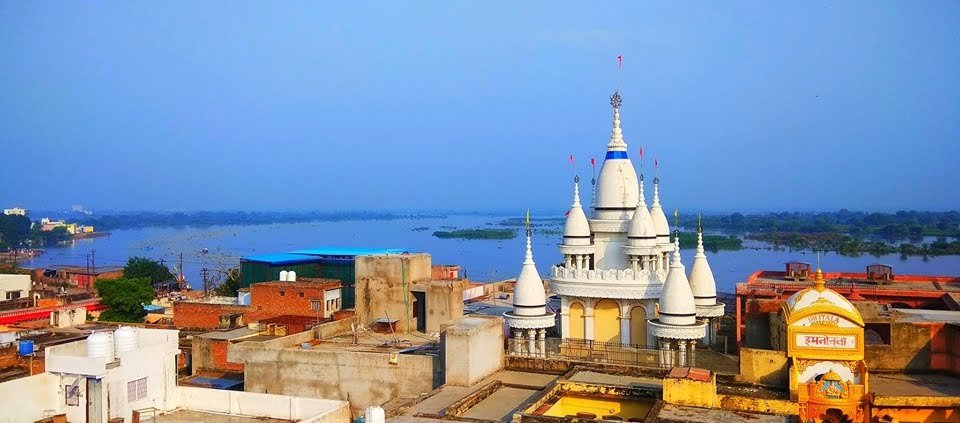Imlitala – Where Krishna Attained Perfection
First published in the printed magazine Vrindavan Today, edition of February/March 2020.
A Siddhapīṭha is a holy place of perfection or siddhi. Usually people know Yogapīṭha – the holy place where Rādhā and Kṛṣṇa meet – such as the Yogapīṭha at the Rādhā-Govinda temple in Vṛndāvana. But despite its unique significance, most people know little about Imlitalā Siddhapīṭha. Normally, Siddhapīṭha refers to a place where sādhakas attain perfection, but in Imlitalā, it refers to a place where Śrī Kṛṣṇa Himself attained a most sublime perfection!

Tamarind tree in Imlitala. PC: Radhamadhav Das
“Imli” means “tamarind tree” and “tala” means “at the base of”. Because Śrī-Śrī Rādhā-Kṛṣṇa and Śrī Caitanya Mahāprabhu performed many amazing līlās under this imli tree, this holy place has come to be known as “Imlitalā.” Imlitalā is counted among Vṛndāvana’s Prācīna-devālayas or most prominent ancient places of worship.
Śrī Caitanya Mahāprabhu arrived in Vṛndāvana on the day of Rāsa pūrṇimā in Kārtika 1515. He daily sat in solitude under this tamarind tree, gazing at the Yamunā and enjoying the divine beauty of Vṛndāvana. He also performed harināma and spread the message of devotion to Śrī Hari to qualified people at this holy place. Śrīla Kṛṣṇadāsa Kavirāja Gosvāmī has described this pastime as follows:
prāte vṛndāvane kailā ‘cīra-ghāṭe’ snāna
teṅtulī-talāte āsi’ karilā viśrāma
kṛṣṇa-līlā-kālera sei vṛkṣa purātana
tāra tale piṅḍi-bāndhā parama-cikkaṇa
nikaṭe yamunā vahe śītala samīra
vṛndāvana-śobhā dekhe yamunāra nīra
teṅtula-tale vasi’ kare nāma-saṅkīrtana
madhyāhna kari’ āsi’ kare ‘akrūre’ bhojana
vṛndāvane āsi’ prabhu vasiyā ekānta
nāma-saṅkīrtana kare madhyāhna-paryanta
“The next morning, Śrī Caitanya Mahāprabhu returned to Vṛndāvana and took His bath at Cīra-ghāṭa. He then went to Imlitalā (Teṅtulītalā), where He took rest. The tamarind tree was very old, having been there since the time of Lord Kṛṣṇa’s pastimes. Beneath the tree was a dazzling sitting platform. Since the river Yamunā flowed near Imlitalā, a very cool breeze blew there. While there, the Lord saw the sublime beauty of Vṛndāvana and the pristine water of the Yamunā. Before returning to Akrūra-tīrtha to take lunch at noon, Śrī Caitanya Mahāprabhu used to sit beneath the ancient tamarind tree and engage in nāma-saṅkīrtana. Whenever Mahāprabhu would come to Vṛndāvana, He would sit here in solitude until noon.”
– Caitanya-caritāmṛta 2.18.75-80.
Śrīla Bhakti Rakṣaka Śrīdhara Dev-Gosvāmī Mahārāja composed a beautiful Sanskrit poem on Imlitalā:
tintiḍī-talastha-yāmunormmi-bhāvanāplutaṁ
nirjanaika-rādhikātma-bhāva-vaibhavāvṛtam
śyāma-rādhikāpta-gaura-tattva-bhittikākaraṁ
prema-dhāma-devam eva naumi gaura-sundaram
“When Śrī Caitanya Mahāprabhu was sitting in solitude under the imli tree and seeing the dancing waves of the Yamunā, He remembered His water-sporting pastimes with the gopīs during His previous Avatāra as Śrī Kṛṣṇa. Embracing the sweetness of Rādhikā’s love in the core of His heart, He entered into rādhikātma-bhāva or empathic union with Her. He thus fulfilled His three internal desires and His heart was completely captured by Rādhārāṇī. Imlitalā is the place of origin of gaura-tattva, for it was here where in Dvāpara-yuga, Śyāmasundara became fully absorbed in the devotional mood of Śrīmatī Rādhārāṇī and became Gaurasundara. I offer my obeisance to that Lord Gaurasundara, who eternally resides in Imlitalā, and who is the abode of prema.”
– Śrī-Śrī Premadhāma-Deva-Stotram, Verse 42.
Over 5000 years ago in Dvāpara-yuga, in Imlitalā, Śrīmati Rādhārāṇī’s supreme victory was celebrated with Her coronation as Vṛndāvaneśvari, the Queen of Vṛndāvana. In Vṛndāvana, the mood of worship is very sweet, because Rādhārāṇī becomes the Supreme Goddess and Kṛṣṇa accepts a role subordinate to Her.
Once, during the performance of Rāsalīlā, Rādhārāṇī was not given Her deserved special attention by Kṛṣṇa. She thus became sulky, left the Rāsa dance and crossed the Yamunā with Her sakhis. In a secluded spot, She sat down and wept. Absorbed in thoughts of Kṛṣṇa, Her empathy with Him reached such an intensity that Her entire body turned blue like Kṛṣṇa. Thus before Kṛṣṇa entered Rādhā’s mood and turned golden, Rādhikā entered into empathy with Him and assumed His dark blue effulgence. Tears cascaded from Her eyes and soon formed a beautiful lake, wich was named Māna sarovar – the lake formed of Rādhā’s tears of māna or sulkiness.
Meanwhile, Kṛṣṇa didn’t feel the usual bliss and realized that His most beloved Rādhārāṇī is missing from the Rāsalīlā. He quickly left the Rāsa dance and began desperately looking for Her everywhere. Unable to find Her, He remembered how She was once crowned the Queen of Vṛndāvana under the tamarind tree in Imlitalā. He thus took shelter of that tree and started crying out, “Rādheee! Rādheee! Please save my life by giving me your darśana!
Rādhārāṇī’s holy name is non-different from Her mood and golden colour. Thus, while chanting Rādhā’s name, Kṛṣṇa soon became immersed into Her mood of service and also attained Her golden effulgence, assuming the golden form of Śrī Caitanya Mahāprabhu! Imlitalā is the holy place where Mahāprabhu’s beautiful form manifested for the very first time. Being immersed in empathy with Rādhārāṇī, Kṛṣṇa got a taste of the glory of Her unparallelled love for Him, of His own sweetness that only She can relish fully and of Her unsurpassed ecstacy when She serves Him. He had thus gotten a taste of fulfilling His three internal desires mentioned by Kṛṣṇadāsa Kavirāja Gosvāmī (Caitanya-caritāmṛta 1.1.6.).
These would later be fulfilled in Purī (dvādaśa vatsara śeṣa rahilā nīlācale (…) āsvādiyā pūrṇa kaila āpana vāñchita – Caitanya-caritāmṛta 1.13.39-43). But even just getting a taste of their fulfillment, Kṛṣṇa entered into a deep state of samādhi and attained a unique siddhi or perfection. This is why Imlitalā is called Siddhapīṭha – holy place of perfection. It is from this seed form of empathic samādhi that Kṛṣṇa’s gaura-līlā exploded infinitely and showered its fruits of gaura-prema on one and all.
On the other side of the Yamunā, Rādhārāṇī suddenly felt deep bliss arising in Her heart due to being immersed in empathic union with Kṛṣṇa. Realizing that He is tasting a very special kind of ecstacy, She was attracted to Imlitalā with Her sakhis and was amazed to find Kṛṣṇa embraced with Her golden effulgence and immersed into a samādhi of empathic union with Her. Usually Kṛṣṇa faints merely by hearing the tinkling sound of Her anklets. But now He was not showing the slightest reaction, altough Rādhārāṇī was standing right in front of Him – such intense was His empathic absorption! One of Her sakhis thus told Rādhārāṇī to snatch back Her mood of devotion from Kṛṣṇa. When She did just that, Gaura-Kṛṣṇa came back to external consciousness, having lost the treasure of rādhā-bhāva. The covering golden effulgence faded and gave way to His blackish colour. The two had a most blissful meeting and were expressing how They are looking forward to continue this Gaura-Kṛṣṇa pastime during Their gaura-līlā in Kali-yuga.
Then, when Kali-yuga arrived, Nityānanda Prabhu came to Imlitalā. He foresaw Mahāprabhu’s arrival and prepared His āsana here. When Mahāprabhu came to Vraja, He spent most of His time on this āsana under this imli tree, chanting Kṛṣṇa-nāma in seclusion. While chanting Kṛṣṇa’s names, due to the seeing the uddīpakas or stimulants of vraja-līlā in Vṛndāvana, for a short time He again turned blackish like Kṛṣṇa and lost the treasure of rādhā-bhāva. To make sure He won’t lose rādhā-bhāva again, He decided to return to Purī, although He had only spent a few months in Vṛndāvana. This is the confidential reason why Mahāprabhu performed His concluding pastime in Purī.
Sevakuñja is accepted as the heart of Vṛndāvana because here Kṛṣṇa attains the treasure of His heart – the service of Rādhārāṇī’s lotus feet. However, nobody can serve without the proper mood of service – especially not Kṛṣṇa, who is used to being ādi-puruṣaṁ, the supreme enjoyer. He has to first attain seva-bhāva, the mood of service. And for that He first comes to Imlitalā before He enters Sevakuñja. In the same mood, according to local tradition, pilgrims first have darśana of Imlitalā before entering Sevakuñja.
Some say that relishing the Imlitalā pastimes was the internal reason for Mahāprabhu’s coming to Vṛndāvana. Under the very same imli tree, Srila Sanātana Gosvāmī worshiped his beautiful Gaura-Nityānanda Deities, which now grace the left altar in the Imlitalā temple. In the centre of the altar there is the Mahāprabhu Deity who was personally installed by Śrīla Bhaktisiddhanta Sarasvatī Prabhupāda and lead all of his early Vraja-maṇḍala parikramās. Imlitalā was so dear to Śrīla Prabhupāda that he once said: “I am living eternally at Imlitalā!”
There is a little known book in Bengali called Imlitalā Mahātmya written by the Founder Ācārya of the Śrī Gauḍīya Saṅgha and Sevait of Imlitalā, Śrīla Bhakti Saraṅga Gosvāmī Mahārāja. We are happy to announce that it has now been translated into English and that it will soon be published. Also, a book called Yoga of Empathy by Radhamadhav Das is in the making and will dwelve deeper into the topic of empathic union. Both publications will be announced here on www.nectarpot.com.
References
- Caitanya-caritāmṛta
- Bhakti-ratnākara
- Imlitalā Mahātmya by Śrīla Bhakti Saraṅga Gosvāmī Mahārāja
- Accounts of senior Vaiṣṇavas
Related Resources
Guided Darshans of Imlitalā and Sevakunja
Gaudiya Sangha in Delhi
How to Get There
Imlitalā lies between the Madan-Mohan temple and Keshi Ghat on the banks of the Yamunā. It belongs to Sevakunja. You can walk there or take a bicycle or E-rikshaw. Cars are not recommended because they disturb the peace of the pilgrims.




Leave a Reply
Want to join the discussion?Feel free to contribute!